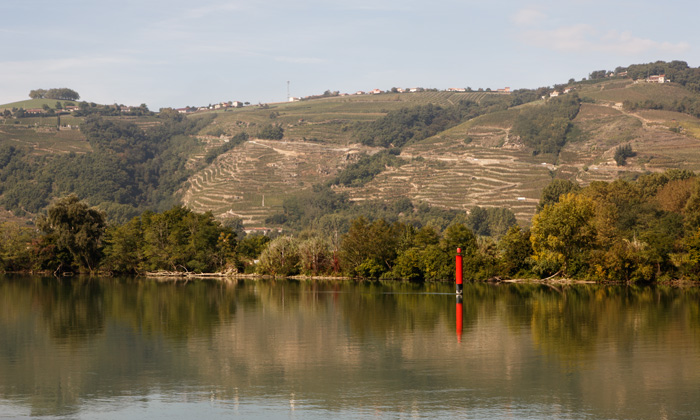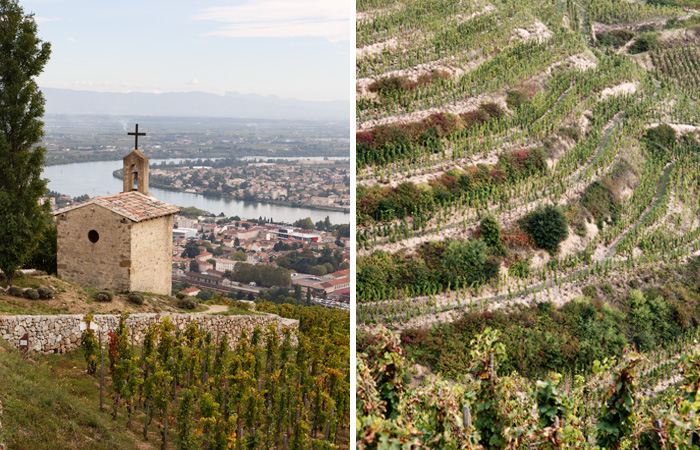A Trip Down the Rhône River; Tasting the 2011 Vintage
Author: Berry Bros. & Rudd
It is late Sunday evening when we arrive at Lyon airport for our annual Rhône En Primeur trip. Wet snow starts to fall heavily as we collect our rental car and race down the motorway to Ampuis, the centre of Côte-Rôtie. Monday morning we wake up to one of my favourite views in the world; the frighteningly steep vineyards of Côte-Rôtie that form the backdrop of Ampuis, shrouded in morning mist. Working these vertiginous hillside terraces (they can be up to 60 degrees) requires a good sense of balance and is a labour of love as all machinery fails on these steep slopes. This mythical landscape is home to some of the world’s greatest wines and we are about to taste them!
We are in Ampuis to start our busy four day tasting trip, to understand the 2011 vintage. In many ways, tasting the wines at this stage makes far more sense than the annual Bordeaux en primeurs; the wines have had an extra year of ageing and in many instances are about to be bottled. It is impossible to do justice to all the producers and wines that we have tasted and the Rhône En Primeur tasting on Monday 25th February gave us a good chance to explore these wines further.
The Northern Rhône is dominated by the magnificent Rhône River, which has its source in the glacial Massif of St Gothard in Switzerland and as it twists and turns its way through the valley, so the vineyard exposure turns with it. Day 1 we focus on Côte-Rôtie itself and we start with Domaine Jean-Michel Gerin. Modern in style with lots of oak, the wines show extraordinary depth despite the relatively young age of the vines. Côte-Rôtie, Champin Le Seigneur is concentrated, seductive and a good continuation of 2009/2010. It may lack some of the concentration of the 2009 and 2010, but gives far more pleasure at this young stage. Côte-Rôtie, La Landonne is exceptional with real finesse and a floral note on the finish that goes on and on. It is a good start. Next on the list are the freezing cellars of traditionalist an d ‘Master Grower’ Réné Rostaing, whose carefully crafted high-toned wines speak for themselves.
Rene Rostaing calls 2011 ‘a year of terroir not of sunshine, like 2004, 2006 and 2001’. These are not rich, luxurious wines, but precise and focused reflecting the minute differences in soil as can clearly be seen between the masculine dark Côte-Rôtie, La Landonne on soils high in iron oxide and the opulent floral seductive Côte-Rôtie, Cote Blonde from calcareous and quartz soil. At Côte-Rôtie Syrah is grown on the most northern edge of where the grape will ripen (like Cabernet Sauvignon in Bordeaux and Pinot Noir in Burgundy). The result is complex wines that reflect vintage conditions and soil, and it is the vintage difference that makes these wines so fascinating.
After Rostaing we drive to Domaine Michel et Stéphane Ogier. The 2011 L’ame Soeur is as good as ever. Produced from vines grown on micro-schist in Seyssuel north of Côte-Rôtie on the left bank of the Rhône, this has become a serious cuvee despite the young 13-year old vines. Seysseul is the area where the first Roman vineyards were planted in the Rhône valley, but lay barren after the destruction of the vineyards by phylloxera at the end of the 19th century.
The vineyards are steep (up to 50 degree gradient like Côte-Rôtie itself) and were first replanted in 1996 by three growers; Yves Cuilleron, François Villard and Pierre Gagnard (today there are 14 growers). This is an area to watch. After lunch, we drove to Domaine Cuilleron to taste a range of whites and stopped at Domaine Laurent Combier on our way to Hermitage. Cuilleron’s focus on whites, reinforced our morning’s tastings that the whites in general are a success story in the Northern Rhône; full bodied with lots of opulent exotic fruit. We liked the domains flagship Crozes Hermitage Clos des Grives with layers of lavish cherries, tapenade and truffles so much that we managed to persuade him to increase our allocation with some large formats (there aren’t many, so worth keeping an eye out!).
Day 2 was dedicated to Hermitage and we started with one of my favourite producers Domaine Marc Sorrel. The quiet Marc Sorrel produces wines that hold a certain mystery. His flagship Hermitage Blanc, Les Rocoules holds the same energy as Coche Dury’s Corton Charlemagne. One can imagine my delight at tasting the 2000 les Rocoules Blanc and 2000 Hermitage rouge, le Greal. It would have been easy to stay all morning and ponder over these wines.
Back to the 2011 tasting trip. From Sorrel we visited Chapoutier and tasted the range of Chapoutier and Domaine Ferraton (bought by Chapoutier in 2007, but the winemaker Damien Brisset has remained and is totally in charge of the winery and vineyards). The Ferraton wines showed very well indeed and still offer great value (worth keeping an eye out for Ermitage Blanc le Reverdy and 2011 Cornas les Eygats). Chapoutier’s Sélections Parcellaires were mind-blowingly good and are a testament to Michel’s Chapoutier’s passion for perfection. Before finishing the day at Domaine Du Tunnel with the amicable Stéphane Robert and some delicious St Peray, we tasted a range of St Josephs at Domaine Coursodon. With pure crunchy fruit and good freshness, this is the appellation that has been most consistent in 2011 for reds.
Day 3 and 4 were totally focused on the Southern Rhône, dominated by the patchwork of vineyards in Châteauneuf-du-Pape and dominated by the dry and chilling mistral wind. Wednesday started well with a visit to Clos des Papes with the It is a good start with the animated Vincent Avril at Clos des Papes. Vincent is a magician in his cellar, with total control over the different casks that age his wine. Vincent is a true traditionalist blending all 13 grape varieties allowed in Chateauneuf du Papes, from 24 different parcels spread over all five villages, giving him the potential to capture the very best that Châteauneuf-du-Pape has to offer in each vintage. We are enthralled when he offers us a vertical tasting of Clos des Papes Rouge….
2008 (Mourvedre dominated on palate, Pommard like spice, keep)
2010 (One of the greatest Clos des Papes, needs time)
2006 (Ready to drink, can keep. powerful)
2005 (More finesse, less structure, keep)
2003 (Decanted, yet a beast that needs more time. Power, licorice rather than elegance)
1995 (Ready to drink but kept evolving, sweet fruit, gentle menthol on finish)
….and Clos des Papes Blanc (can be drunk at all ages and depends on style. In youth it displays an array of exotic fruit and is very pretty, with 3-5 years it takes on a mineral character reminiscent of Riesling and with 5-10+ years it takes on honey and roasted hazelnuts)
2011 (Starfruit, acacia, white flowers, enticing. This is serious and has the potential to age for a long time. I must remember to put a case in my cellar)
2005 (Very minerally, with a note of kerosene and a pretty floral lift on the finish)
2001 (Starting to show evolution with a touch of honey and hazelnuts. Reminiscent of aged Semillon. Vincent opens this for his Burgundian friends at the moment)
1991 (fully developed, keeps giving more in the glass. Good volume in the mid palate. Similar to aged Riesling, but with a noticeable floral lift).
So what about 2011 Clos des Papes Rouge itself. It is a powerful red with silky tannins and a floral lift on the mid-palate that is very attractive. Vincent himself suggest that 2011 is a blend of 2/3 2009 and 1/3 2008; the power of 2009, with the elegance and finesse of 2008 (and cleaner fruit than in 2008). The second visit of the day is to Domaine du Pegau; if Vincent likes to 100% destem his bunches, Laurence prefers to use whole bunches.
If Vincent is committed to making one wine and no single cuvée, Laurence produces in most vintages a single cuvée (cuvée Laurence or in outstanding vintages the famous Capo) in addition to her Cuvée Reservee. Both producers have one thing in common; no new oak! Laurence has produced rich, savoury wines in 2011. Wednesday is a long day and in quick succession we visited La Bastide St Vincent (some great Gigondas), Domaine des Sénéchaux (one of the oldest domains in Châteauneuf-du-Pape and owned today by Jean-Michel Cazes (from Ch. Lynch Bages) and Domaine de la Janasse. Janasse was founded in 1973 by Aimé Sabon and is now run by Christophe Sabon and is now run by the pragmatic Christophe and his sister Isabelle.
The domaine is 80% organic, but they are not looking for certification as they want to be able to interfere if the vineyards require it. The winery is a simple structure, but money is spent where it truly matters and Christophe has installed temperature controlled cement vats similar to those found at Cheval Blanc. The entire range is impressive and without doubt the wines are among the best produced in 2011.
In general the 2011 Southern Rhône wines are attractive for their sweet red fruit, the gentle spice, but noticeable high alcohol due to the high percentage of Grenache. The Northern Rhônes show pure black fruit fruit, very terroir sensitive and the best display floral notes that dance across the palate.







This is very interesting, but I wish you’d look at some of the other – less expensive – wines of the Rhone: Vacqueras, Gigonas, Sablet etc. I’d also like to see the wines of the Beaujolais, very close to my heart, given a similar coverage; there’s too much snobberty and ignorance in that area.